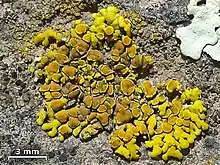Placomaronea candelarioides
Placomaronea candelarioides is a species of saxicolous (rock-dwelling), foliose lichen in the family Candelariaceae.[1] It is found in South America. This lichen species can be recognised by its distinct umbilicate (single attachment point), monophyllous (single lobe) growth form.
| Placomaronea candelarioides | |
|---|---|
 | |
| in Ollantaytambo, Peru | |
| Scientific classification | |
| Domain: | Eukaryota |
| Kingdom: | Fungi |
| Division: | Ascomycota |
| Class: | Candelariomycetes |
| Order: | Candelariales |
| Family: | Candelariaceae |
| Genus: | Placomaronea |
| Species: | P. candelarioides |
| Binomial name | |
| Placomaronea candelarioides Räsänen (1944) | |
Taxonomy
Placomaronea candelarioides was formally described as a new species in 1944 by Finnish lichenologist Veli Räsänen. It is the type species of the genus Placomaronea, which was circumscribed by Räsänen to contain this species. The type specimen of P. candelarioides was found in Mendoza, Argentina.[2] A variety of this lichen, Placomaronea candelarioides var. lacinulata, was proposed by Rolf Santesson in 1944.[3]
Description
Placomaronea candelarioides has a leaf-like (foliose) structure, uniquely anchored by a single point, a trait referred to as umbilicate and monophyllous. Though most specimens adhere to this typical appearance, some have shown variations, such as having numerous individual, little branched, and ascending lobes that attach to the substratum at the base. The lichen's overall shape is circular and can span up to 20 mm (13⁄16 in) across. It has extensions or lobes that radiate from its centre, each measuring between 0.4 and 1.7 mm in width and potentially growing up to 7 mm in length. These lobes sometimes have smaller offshoots or lobules and can occasionally take on a round shape, layering over each other and forming cushion-like clusters. The colour of the lichen's upper surface ranges from dark yellow to brownish-yellow, presenting a smooth, shiny, and unpigmented appearance. The lichen's underside can display colours from white to grey or even brown, influenced by the dust it accumulates.[4]
Prominently, the lichen's apothecia appear as darker yellow spots that often densely populate the central regions of the lichen. They sit raised on the surface, measure between 0.5 and 1.6 mm in diameter, and sometimes have a slightly jagged or crenulate edge. Internally, the lichen comprises several layers. Just beneath the surface, there is a cortex layer about 15–35 µm thick. Below this, a white layer of medulla. The base of the lichen has another cortical layer, which is similar in structure but slightly thicker, ranging between 25 and 45 µm.[4]
Each ascus holds over 30 ascospores. These spores are narrowly oval in shape, measuring between 8–12.5 µm in length and 3–4 µm in width. Another distinguishing feature is the presence of pycnidia, which appear as darker yellow dimples on the lichen's surface.[4]
In chemical spot tests, the lichen reacts weakly red when a solution of potassium hydroxide (K) is applied, a feature helpful for its identification.[4]
Habitat and distribution
Placomaronea candelarioides thrives on acidic rocks within open montane environments. It has been identified in numerous locations along the Andes, extending from Mendoza, Argentina in the south, up to Ancash, Peru in the north.[4]
References
- "Placomaronea candelarioides Räsänen". Catalogue of Life. Species 2000: Leiden, the Netherlands. Retrieved 11 October 2023.
- Räsänen, V. (1944). "Lichenes novi I". Annales Botanici Societatis Zoologicae Botanicae Fennicae "Vanamo". 20 (3): 1–34.
- Santesson, R. (1944). "Contribution to the lichen flora of South America". Arkiv før Botanik. 31A (7): 1–28.
- Westberg, Martin; Frödén, Patrik; Wedin, Mats (2009). "A monograph of the genus Placomaronea (Ascomycota, Candelariales)". The Lichenologist. 41 (5): 513–527. doi:10.1017/s0024282909990156. S2CID 90349733.